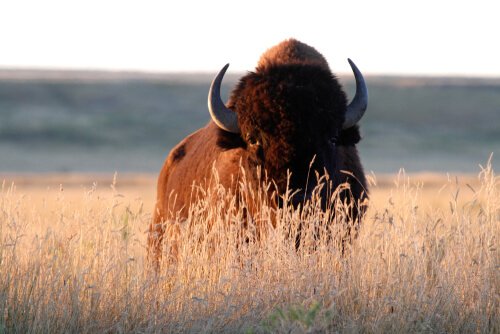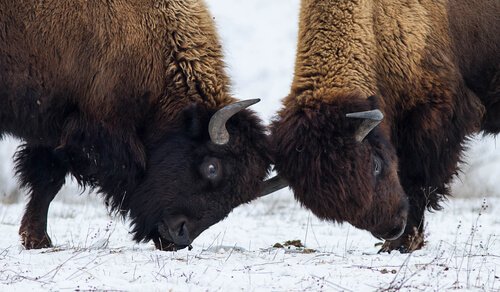Learn why the American bison was once the symbol of the Great Plains
The American bison is a large hoofed hoof mammal . This means that it is supported and walked with the end of the fingers, which are covered by the hooves. Its natural habitat is found among the Great American Plains.
Although some people call it buffalo, the American bison has no relationship with the African buffalo species , which is the only species of true buffalo in the world. The American bison is more closely related to cows and goats.
Its role as an American symbol
The American bison has some of the most dramatic stories about the human impact on the environment. In the seventeenth century, approximately 60 million of these animals roamed the plains of North America. After the arrival of the colonists, this species was expelled from its natural habitat.
They were hunted ruthlessly and in 1890 there were less than 1,000 surviving specimens . The native man had traditionally hunted the bison in search of food, tools and furs, but the massacre of the Europeans was mainly for sport.
With a fortuitous vision, the American Bison Society was formed in 1905 to ensure the survival of this species . With the help of captive breeding and reintroductions to nature, the population of American bison is now relatively safe.

This specimen is an Ice Age survivor , the largest land mammal in the United States. United and an ancient symbol of freedom, strength and self-determination. His image has been engraved on nickel coins and is the official seal of the United States Department of the Interior.
Despite the almost insurmountable challenges, a diverse group of Americans came together to avoid the extinction of the bison . Their combined effort resulted in one of the first success stories in conservation in the country. Thanks to their dedication, the public began to see the bison as more than a source of leather.
Physical characteristics of the American bison
The coat of the American bison is brown dark and long in the front . Individual hairs are usually 50 centimeters long and on rare occasions the coat is gray, mottled or cream colored. The calves are born light reddish brown, but change to dark brown at about six months of age.
On the forehead, the hair is shaggy and curly, which gives it a mop-like appearance among the horns His shoulders are massive and hunchbacked, and he keeps his head down . Antlers are present in both sexes; they arch backwards, outwards and then upwards, to bend slightly at the tips.
The length of their body ranges between 3 and 3.5 meters in length, and measures 1.95 meters of high approximately. Its tail is 30 to 90 centimeters and in its adult stage a bison can weigh between 500 and 1 000 kilos . Despite the dimensions, this animal can walk at speeds of 50 km/h and perform jumps of up to two meters in the air.
Behavior and reproduction habits
Known by travel great distances, the American bison moves continuously while eating . The females lead the family groups, while the males remain solitary or in small groups for most of the year.

The bison adapt to the extreme weather conditions of the Great Plains strong>.The wallowing creates a small depression in the earth similar to a huge plate. This was a common feature of the Great Plains and, in general, these land spaces were only dust bowls without vegetation.
The males have a solitary life until the time of reproduction . This happens between the months of June to September: then the males will hit each other with their heads in an attempt to attract the attention of the females.
In the first semester of the following year, the female will give birth to only one calf . These pups lack the characteristic hump of adults. After six months, when he begins to change the color of his coat, the hump will gradually appear.


